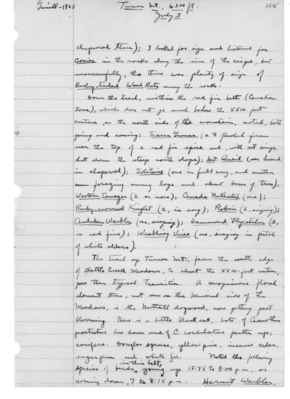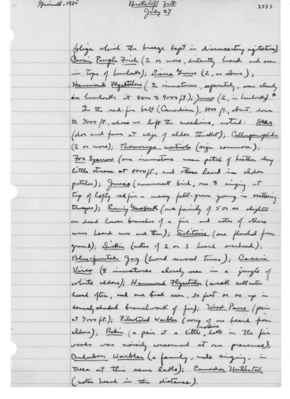Pages That Mention Sierra Sooty Grouse
1925: Joseph Grinnell's field notes
S2 Page 65
Collector: Grinnell - 1925 Location: Turner Mt., 6300 ft. Date: July 3 Page Number: 2518
chaparral there); I looked for sign and listened for Conies in the rocks along the rim of the cirque, but unsuccessfully, tho there was plenty of sign of Bushy-Tailed Wood Rats among the rocks.
Down the trail, within the red fir belt (Canadian Zone), which does not go much below the 5500 foot contour, on the north side of the mountain, noted, both going and coming: Sierra Grouse (a [male symbol] flushed from near the top of a red fir spire and, with set wings, shot down the steep north slope); Mt. Quail (one heard in chaparral); Solitaire (one in full song, and another seen foraging among logs and about bases of trees); Western Tanager (2 or more); Canada Nuthatch (one); Ruby-crowned Kinglet (2, in song); Robin (2, singing); Audubon Warbler (one, singing); Hammond Flycatcher (2, in red firs); Warbling Vireo (one, singing in patch of white alders).
The trail up Turner Mt. from the south edge of Battle Creek Meadows, to about the 5500-foot contour, goes thru [sic] typical transition. A conspicuous floral element there, not seen on the Mineral side of the Meadows, is the Nuttall dogwood, now getting past blooming. There is a little black oak, lots of Ceanothus prostratus low down and of C. cordulatus farther up; conifers: Douglas spruce, yellow pine, incense cedar, sugar pine, and white fir. Noted the following species of birds ^in this belt, going up 12:45 to 3:00 p.m., or coming down, 7 to 8:15 p.m.: Hermit Warbler,
S2 Page 81
Collector: Grinnell - 1925 Location: Broke-off Mt. Date: July 27 Page Number: 2533
foliage which the breeze kept in disconcerting agitation); Cassin Purple Finch (2 or more, distantly heard and seen in tops of hemlocks); Sierra Grouse (2, as above); Hammond Flycatcher (2 immatures, separately, seen closely in hemlocks at 8000 to 9000 ft.); Junco (2, in hemlocks).*
In the red-fir belt (Canadian), 8000 ft., about, down to 7000 ft., where we left the machine, noted: Deer (doe and fawn at edge of alder thicket); Callospermophilus (2 or more); Thomomys monticola (sign common); Fox Sparrow (one immature near patch of heather along little stream at 8000 ft., and others heard in alder patches); Juncos (commonest bird, one [male symbol] singing at tip of lofty red fir - many full-grown young in scattering troupes); Evening Grosbeak (one family of 5 or so alighted on dead lower branches of a fir and notes of others were heard now and then); Solitaire (one flushed from ground); Siskin (notes of 2 or 3 heard overhead); Blue-fronted Jay (heard several times); Cassin Vireo (2 immatures closely seen in a jungle of white alders); Hammond Flycatcher (weak call notes heard often, and one bird seen, 30 feet or so up in densely shaded branchwork of fir); Wood Pewee (pair at 7000 ft.); Pileated Warbler (song of one heard from alders); Robin (a pair at a little ^moraine lake in the fir woods was noisily concerned at our presence); Audubon Warbler (a family, male singing, in trees at this same lake); Canada Nuthatch (notes heard in the distance).

